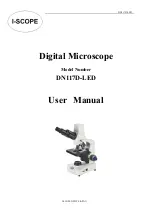
S y s t e m O v e r v i e w
8
Model 1010 Ion Mill
Standard Magnification Version
range. The scale is 1 to 10, with 1 being the most sensitive. These values are selectable in
the Ion Milling Program.
Note: Termination thresholds vary greatly based upon material and the desired
perforation size. Experimentation with varying parameters is necessary to obtain the
optimum termination point for different types of materials.
Visual Monitoring
The progress of an ion milling operation is monitored visually by using the standard
magnification stereo microscope. The magnification range with 10X eyepieces is 7 –
45X.
Control System and Software
All operations are controlled using four independent software programs.
Ion Milling Program
Controls the milling operation. Allows the user to select milling parameters and
create the conditions necessary for manual or automatic operations.
Dewar Bakeout Program
Controls the heating process for maintaining the Dewar insulation and Zeolite®
desiccant. Opens the vacuum connection, raises the temperature, and controls
the time at temperature
Laser Detector Calibration
Program
Calibrates the laser detector according to the transmissive properties of the
window protecting the laser sensor. Allows the user to choose the minimum
and maximum sensitivity values.
Data Logging Program
Controls logging, retrieval, and display of milling parameters.
Specifications
Ion source type
Hollow Anode Design
Ion source settings range
Voltage: 0.5 – 6 kV, Current 3 – 8 mA
Specimen motion
Full rotation (360
o
) or oscillation (0 to +/- 179
o
)
Milling rate
Varies with material
Control platform
PC compatible
Dimensions
33 in. wide by 19.5 in. deep by 26.5 in. high
Weight
115 lb (52 kg)
Power requirements
60 Watts
Water requirements
Temperature of the inlet water is not critical but should be maintained between
+5
°
C and room temperature. Water flow should be approximately 0.5 lpm.
Gas requirements
Argon equal to or greater than 99.998% and supplied at a pressure of 10 psi
(69 MPa)
Microscope capability
7-45X stereo zoom microscope
Turbomolecular vacuum
pump
70 lps (minimum). With no gas flow, ultimate chamber vacuum is 1 x 10
-6
torr.
Under normal milling conditions, the system vacuum is between 1 x 10
-4
and 2
x 10
-5
torr








































